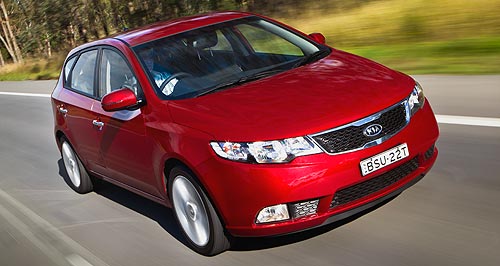New models - Kia - Cerato - HatchFirst drive: Hatch completes Kia Cerato armouryShift for the better: Kia's new five-door Cerato Hatchback marks the debut of a new six-speed automatic transmission. Finally, Kia can take on small-car big boys with new Cerato Hatchback22 Oct 2010 By PHILIP LORD KIA finally can take on all comers in the Australian small-car market with the arrival of the hatchback version of its Cerato, expanding its sales potential by up to 50 per cent. Until now, the Korean importer has been armed only with its Cerato sedan in the hatch-heavy small car market – Australia’s biggest – that is led by the Toyota Corolla and Mazda3 (Kia’s two-door Cerato Koup is classed as a sportscar). The new five-door Cerato not only rectifies this issue but also addresses another of the Cerato’s shortcomings: its much maligned, outdated four-speed automatic transmission. The Cerato Hatchback marks the debut of a new six-speed auto and manual transmissions that also are destined for the sedan and Koup in January 2011. As well, the hatch gets new locally tuned suspension to refine it for Australian roads and address another common gripe about the Korean tuned cars. So far this year, Kia has sold 2506 Cerato sedans in Australia – up 30 per cent on the first nine months of last year, but giving it only a tiny 1.4 per cent of the small-car market. This compares with Korean rival – and parent company in Seoul – Hyundai’s 10.6 per cent with the i30 hatch.  The new Cerato Hatchback’s engine remains the 2.0-litre Theta II four-cylinder petrol with 115kW of power at 6200rpm and 194Nm of torque at 4300rpm, providing the manual hatch with acceleration from zero to 100km/h in 9.1 seconds and a top speed of 190km/h. The new Cerato Hatchback’s engine remains the 2.0-litre Theta II four-cylinder petrol with 115kW of power at 6200rpm and 194Nm of torque at 4300rpm, providing the manual hatch with acceleration from zero to 100km/h in 9.1 seconds and a top speed of 190km/h.The replacement transmissions, especially the six-speed auto, put Kia at the forefront of the small-car class for gear ratio quantity. Kia says the manual gearbox’s higher gear ratios reduce revs while cruising to improve fuel economy. The new six-speed automatic has a manual mode, which can be operated by the gear lever or steering-mounted paddle shifters in the upper-spec SLi. Fuel consumption figures for the combined cycle are 7.5L/100km and 7.7L/100km for manual and auto respectively, with the CO2 output 179g/km and 183g/km. The manual hatch weighs 1302kg the auto adds 26kg. Towing capacity is 450kg unbraked and 1200kg braked. Like the recently launched Sportage, local engineering input has addressed a regular complaint regarding Korean vehicles – their lack of appropriate suspension tuning for local conditions. Uprated spring and damper rates plus re-rated anti-sway bars are the result of four-plus months of local development testing on Aussie roads, focussing on the rough back roads of New South Wales’ Hunter Valley. Kia’s senior product planner Nick Reid said at the media launch that the engineering team’s goals were improved body control and ride comfort. Aside from allow local suspension engineers to fettle with steering, Kia claims that the new steering system (replacing hydraulic power-assist currently in Cerato sedan and Koup) improves fuel economy by up to three per cent. Kia says it has improved noise, vibration and harshness (NVH) suppression with the introduction of the Cerato hatchback, with foam applied to A, B and C-pillars, a thicker parcel tray material, heavier-density cargo area carpet, a thicker dash panel material and other changes. The Cerato hatchback comes in two grades, Si and SLi. The decision not to include a base-grade S model is attributed to Kia’s focus on supplying fleets with the Si grade. The Hatchback is distinguished externally by a new roof and rear side panels, C-pillar, taillights and tailgate. To distinguish it further from other body variants it also features a tailgate spoiler, unique rear bumper with lower splitter, grille, lower air intake and fog lights. Both models feature Bluetooth, keyless entry, cruise control, steering-mounted controls for cruise and audio, six speakers, iPod/USB compatibility, power windows and doors, air conditioning, mirror-mounted side repeaters, 60-40 split rear seat and a full-size spare wheel. The Si sits on 15-inch steel wheels while the SLi receives 17-inch alloy wheels. Safety features include front, front side and curtain airbags, ABS brakes and stability control. Kia says that the United States, the National Highway Traffic Safety Administration (NHTSA) scored the Cerato Hatchback a five-star crash rating, with 19 out of a possible 20 points. Locally, Kia says it expects the Cerato Hatchback to score a four-out-of-five result in the Australian New Car Assessment (ANCAP) crash test score ratings, the same as the sedan. Aside from the paddle shifter now available in the automatic version, the SLi adds suede-look cloth seat material with red stitching (or optional leather), leather-look gearshift surround, chrome edge trim around the twin cup holders, unique centre console, unique rear splitter with a cut-out for the exhaust tip and rear parking sensors. Despite sharing the same overall width, height and wheelbase as the sedan, the hatch’s rear overhang is 190mm shorter, bring the overall length to 4340mm Kia claims that the cargo capacity is best in class, with a maximum volume of 385 litres. The new Cerato five-door Hatchback arrives in Australia in a choice of nine eye-catching colours: Clear White, Ebony Black, Spicy Red and Racing Red, Metal Bronze, Bright Silver, Titanium Silver, Santorini Blue and Sweet Orange.
 Quick testsRead more15th of October 2010  Sydney show: Kia sets sail with Cerato hatchKia launches its crucial Cerato small hatch in Sydney, and unveils 2011 OptimaCerato pricingMotor industry news |
|
||||||||||

















Facebook Twitter Instagram